Brad Paisley talks writing with Fogerty and Jagger, and reveals his live guitar rig
In depth with the country music megastar

Introduction
The world’s favourite guitar-toting country star returned to Country To Country festival ahead of a brand-new studio album release. We find out what’s been happening in Paisley World, including a new signature Tele… at last!
Stardom of this magnitude is hard to comprehend for guitar players in 2017. Precious few six-string slingers can hold a candle to their Instagram-generation teen-pop contemporaries, but Brad Paisley is different.
In a few hours he will play the O2's gigantic Arena to a sold-out house for the Country To Country festival
Singer, songwriter, TV personality, household name in the USA, he has his own line of boots, clothes and accessories at the US retail giant Boot Barn, and he’s won so many country music awards they just decided it’d be easier for him to host the CMAs instead.
A quick check of his recent single release, Today, returns a cool 31 million views on Facebook confirming, should you be in any doubt, that Brad Paisley is colossally famous. Not bad for a guitar picker from West Virginia.
Today he’s jetted in to London from Europe where he and his family were on a brief vacation. With his signature Santa Cruz and prototype signature Tele in tow, he’s showing us pictures of his kids at the Star Wars exhibit at London’s O2 as photographer Olly snaps frames.
In a few hours, he will play its gigantic Arena to a sold-out house for the Country To Country festival, during which time we get to chat and take a squizz around his European touring rig.
First up, 31 million views for the latest single’s video on Facebook? It wasn’t that long ago that no record company on Earth would give away the first single from an album…
“Yep, you’re calling it,” agrees Paisley. “When I’d finished the song and it was about to be out for radio, I started showing a few of my friends the video I’d been working on. It was all videos that I’d compiled from the internet.
“I’d gone through and found people that were using my music, and said, ‘Can I use your video for this new song?’ I figured that would be a good place to start, because if they were using my music then they were probably going to be okay with it.
“So we rushed to get it out, didn’t monetise it or anything - just stuck it on the Facebook page and my record label, to their credit when they saw the video, said, ‘It’s just important that people see this.’ And that was awesome.”
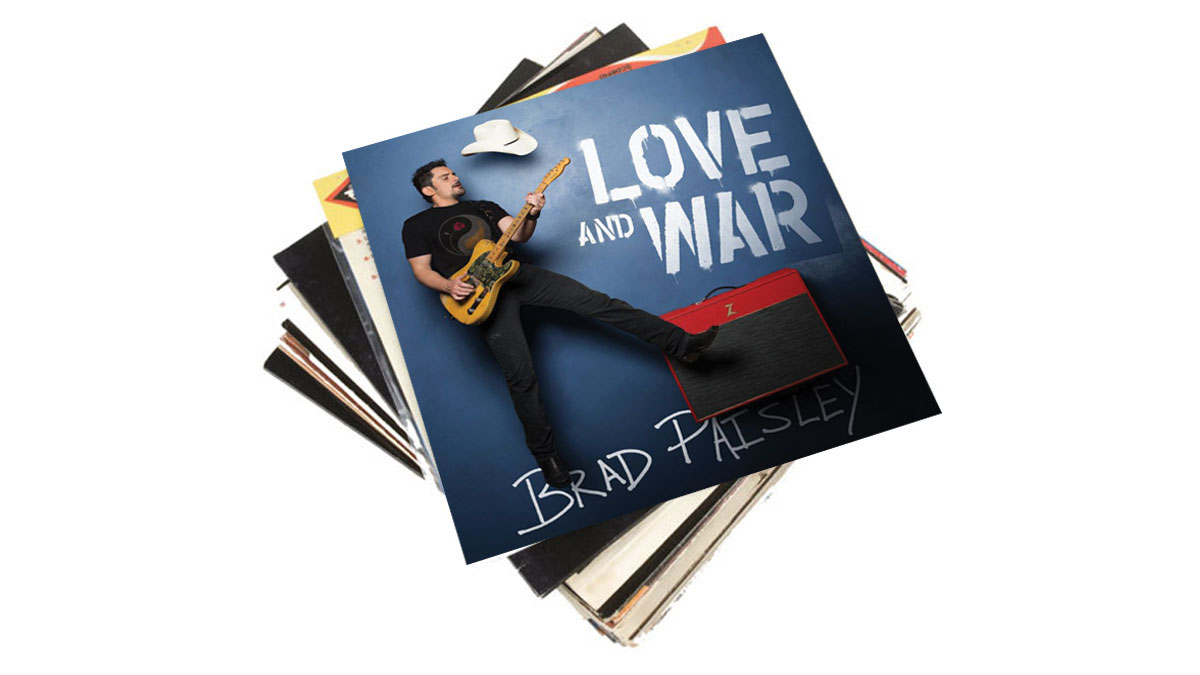
Love And War
It’s been over three years since your last record - what can we expect from Love And War?
“I’ve never had anything more than 18 or 24 months between albums before, and it’s because I’m a year late! It kept not being ready. It was a writing thing, but also a production thing… I’m not one of these people who tweaks to the detriment - the more time I have, the better it’ll get, so you have to have time. I think it’s my best album yet. Someone will disagree!”
There are some new collaborations - Timbaland and Mick Jagger for starters…
“Yeah and [John] Fogerty, too. And there’s a lot of guitar on this record. These are songs that mean a lot to me; some in what they say and others in just the chance to even get to do that!
John Fogerty’s just a master at going BLAM! - here’s a guitar lick that any guitar player or bar band is going to want to learn
“For example, to record and write with Mick [Jagger] and see how his mind works and yet come up with something that represents us both. You’ll hear the song and it’ll sound like me on my part and it’ll sound like him on his part.
“Same with Fogerty, writing wise. With guitar riffs he’s just a master at going BLAM! - here’s a guitar lick that any guitar player or bar band is going to want to learn. In fact, the Fogerty thing [Love And War] was an example of where I had the song idea. I knew exactly what it was and I thought, ‘If I don’t write this with John Fogerty, I’m crazy!’
“My fear was that he didn’t want to say what I’m saying, but he did. The song is a statement. It’s something that I think everyone can agree on - it’s about the mistreatment of the veterans of war and who better to say it than Fogerty? When I say it, it’s ‘Well, bravo.’ When he says it, I think they’ll listen. We may actually make a difference with him saying it.”
The classic Brad Paisley mix seems to draw together those serious and more reflective subjects - such as the latest single, Today - with the more tongue-in-cheek and fun songs. Presumably we can expect that side of you, too, on Love And War?
“Yes. In fact, I’m going to do one tonight and I’m going to do it acoustically. It’ll be interesting to see if the crowd gets it. It’s called selfie#theinternetisforever. It’s about a year old and I’ve played it in concert a little bit. It’s actually something I wrote for a stand-up comedy night, but it works as a country song.”
And the blazing guitar instrumental? Or at least plenty of blazing guitar in general?
“Oh yes! The thing with Mick [Jagger, Drive Of Shame], for example, that’s a rockin’ thing. I’m doing all the leads on that and he’s actually playing some Strat rhythm. He’d probably smack me for this, but when he plays rhythm he sounds a lot like Keef! He has a thing - I think it’s where they place the beat.
“Two of the things with Timbaland have some of the best guitar. There’s a thing called Grey Goose Chase that has a lot of fast stuff, and then there is a song called Contact High, which is a 6/8 blues jam and we had about a three-minute guitar solo at the end that we planned on fading after about 30 seconds… Instead, we left it all in, and it just ends when you hear me go, ‘Yeah…’ We left the entire thing.”

Blazing saddles
The more established your career has become, presumably the easier it became to make decisions like that. How does that compare with the beginning where blazing guitar solos maybe weren’t so welcomed?
“It was a big discussion with the record label at the beginning. My label was concerned that I wouldn’t be considered as a contender for superstardom because I was more of a musician.
My label hid that lead playing side from radio with the first few singles and it wasn’t hard to do because they had no guitar solos
“You know, ‘He’s a lead guitar player… He’ll have some hits, play lead and he’ll never be as big a star as George Strait,’ or whatever. So they hid that from radio with the first few singles and it wasn’t hard to do because they had no guitar solos!
“My first single was Who Needs Pictures; the second single was He Didn’t Have To Be. I played all the electric and acoustic guitars on those tracks, but you wouldn’t wonder who that is because it’s just tasteful ballad guitar playing.
“He Didn’t Have To Be had a steel solo… But now I’d never stand for that [Brad is now laughing]. There would have to be a guitar solo in that son of a gun! By the third single, which was Me Neither, I was saying, ‘Can we please, now… let me cut loose a little bit?’”
Can you talk us through the main guitars on the new record?
“Pink is on there a little bit [Brad’s famous 1968 Pink Paisley Fender Telecaster]. There’s also a ’52 Tele that I use a lot. In fact, there are two of these where I replaced the pickguard with the black paisley - that’s the one on the single art [Today]. In fact, that’s the live one.
“The original one I had was killed in the Nashville flood, so Bill Crook - the boutique maker I work with a lot - he took the thing and had it for a year, dried it, got all of the guk out of it - I mean there was stuff growing in that guitar!
“It finally dried and he put it back together and fixed everything. We stuck a pickup in there, by a guy named Jim Rolph, which is really rare - he doesn’t make many of them. In fact, it’s a pickup he made for Keith Richards. But that guitar is probably 75 per cent of the record. There’s just something very special about it… it might be because it was in the flood and dried out and changed.”
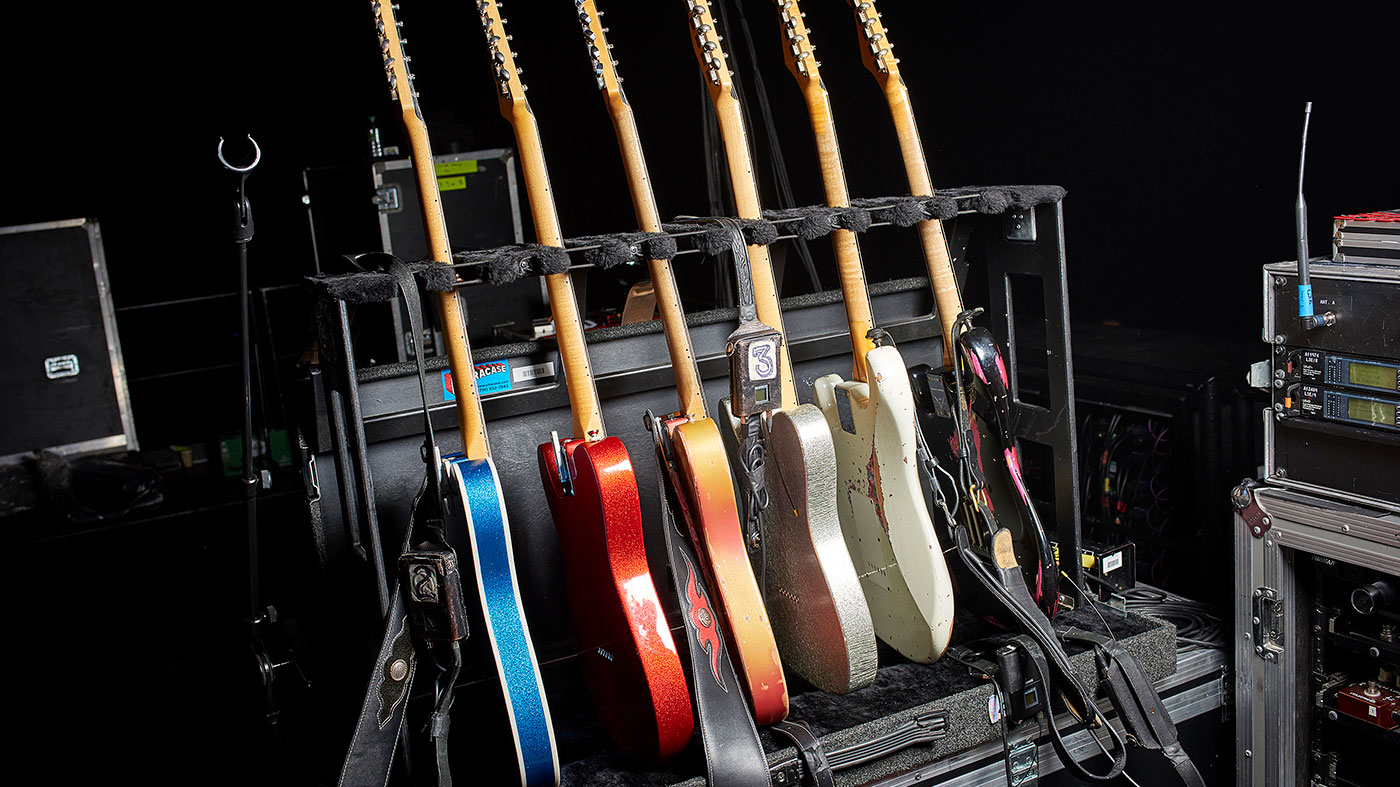
Prototype
There’s a prototype signature guitar we’ve spied in the rack… It must be the most overdue signature guitar ever from Fender!
“You know what it took? Fender has become an amazing, heartfelt company. They feel like they’re no longer this big, cold… they aren’t that now. They are all about the guitar player from what I’ve seen.
Weight is a big deal for me. My silver ’63 is 6.8lbs and it’s the one they based this new signature guitar on
“It’s coming out this summer [and has now been announced - Ed] - did you get to pick it up? [The body is] made out of paulownia and it’s super-light. Weight is a big deal for me. You can find a good heavy guitar, but when you find a vintage Tele that weighs around seven pounds, oh man! My silver ’63 is 6.8lbs and it’s the one they based this new guitar on. That one has a rosewood ’board and the signature guitar has maple.
“They’re making some that will be Custom Shop and expensive, but most people can’t afford that. I thought, ‘What if we could do something amazing for an affordable price?’ $800 or near that is what it’s going to be. I paid more than that, comparably, for some of my first guitars back in the '80s.”
And a new Dr Z amp, the DB4. How does it differ from the Z Wreck?
“This new album is 90 per cent DB4: it’s insane! It’s thicker, it’s less stereotypical Vox, more black-panel, four-input AC30 in terms of character, but it’s way louder than one of those. It’s as loud as a Top Boost AC30 and it’s as clean, headroom wise, as a Top Boost, but it’s thicker. It doesn’t have that scoop. It’s a blistering smack!”
Is that down to the new preamp tube, or something else?
“Yes, it’s down to the preamp tube [a 5879]. It’s still a cathode-biased, four-EL84 output stage… the transformer may be different, I’m not sure about that. But it’s the most perfect amp I’ve ever plugged into for me, especially for a new amp.
“I mean, I have some great vintage amps that I’ve played and a couple of Trainwrecks that are perfect as well - but nobody is ever going to be able to buy one of those. This amp is something really special that you have to hear to believe, I think.”

Per-plexi-ng
And the Plexis? We’re seeing Plexis on stage up there…
“What I use a Plexi for - 100 watters, I don’t like 50s - is that if you think about being up on that stage in this arena, I use it like a sub. It’s not a sub, of course, but it’s really fun when you have the DB4 that’s grabbing your voice, and an old 60s or 70s Marshall paired up with it.
“They couple together really well. They’re actually much cleaner than you think - I mean 100 watts, they’re still clean past noon. So in a big room like this, you still feel the weight of it, and the weight of it is where it’s at, live.”
I’ve got Celestion Alnico Creams that I’m running the Plexi through, so in some ways it sounds like a big Vox!
And are you still a big fan of Alnico speakers as well?
“Yep. I’ve got Celestion Alnico Creams that I’m running the Plexi through, so in some ways it sounds like a big Vox! Like an AC100 or something, but they’re wild. I had one of those catch fire before and that’s not a good idea…
“The DB4 uses [Celestion] Blues. I like the Blues and the Golds in the Z Wreck because you can mic either one, but I like the Blues in the DB4. Creambacks are a little bit dark, which works because those Marshalls have plenty of high-end!”
And with that, our chat draws to a close. Tonight’s headliner is needed for the handshakes, meets and greets that go with the trappings of superstardom. Just a short time later and Brad is stood in front of a sold-out O2 Arena crowd, rounding off the first night of the festival in spectacular style.
And in what’s become a show regular after the first verse of This Is Country Music - tonight played on a Fender Paramount Series dreadnought - Paisley stops the song, takes the guitar off, signs it with a Sharpie and picks somebody in the first couple of rows.
Tonight’s lucky recipient of the acoustic is a young girl and as he hands it down to her, he reminds her mother to make sure she practises so that she can be stood on this stage one day. Total class. 20,000 people end the night loving him just a bit more than they did three hours ago, us included.
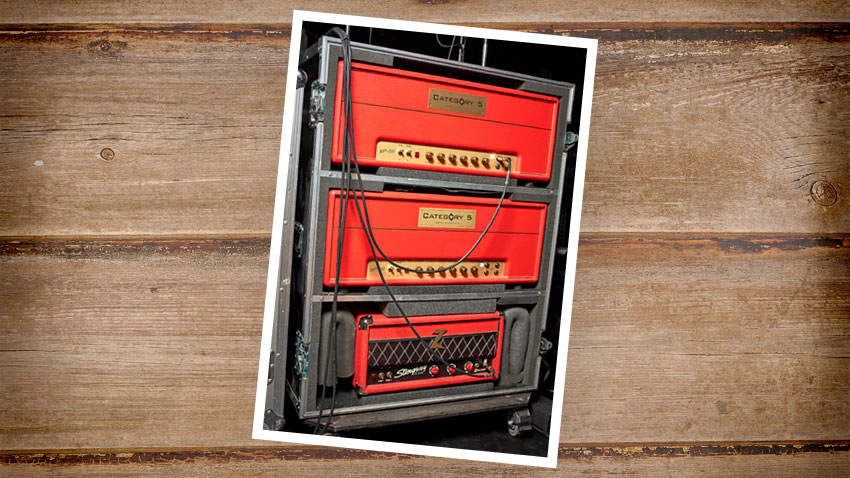
The Stage Rig… Well, Half Of It
For Brad’s Country To Country performance, he was travelling with half his usual rig! “Yep, in the US, there’s a lot more,” laughs tech, Dave Rouze, as he shows us around the rig and stage…
Brad’s ‘Plexis’ are in fact custom-build 100-watters from US company Category 5. One of them drives a 2x12 cabinet on stage alongside a 2x12 Dr Z DB4, with both amps running all the time. The third cabinet is a spare.
The combination of the two amps is everything. It’s all about the mix of the sounds for the tones he wants
“The combination of the two amps is everything,” comments Rouze. “We don’t do stereo, but as I said, this is only half of it. In the US, there’s a lot more - an additional DB5 and either an AC30 or another EL84 Category 5 for some other sounds. It’s all about the mix of the sounds for the tones he wants: the EL84s and the Marshall sounds, or the DB5 and the Vox and so on. The DB4 is wide open, and the Plexis are run with a power soak.
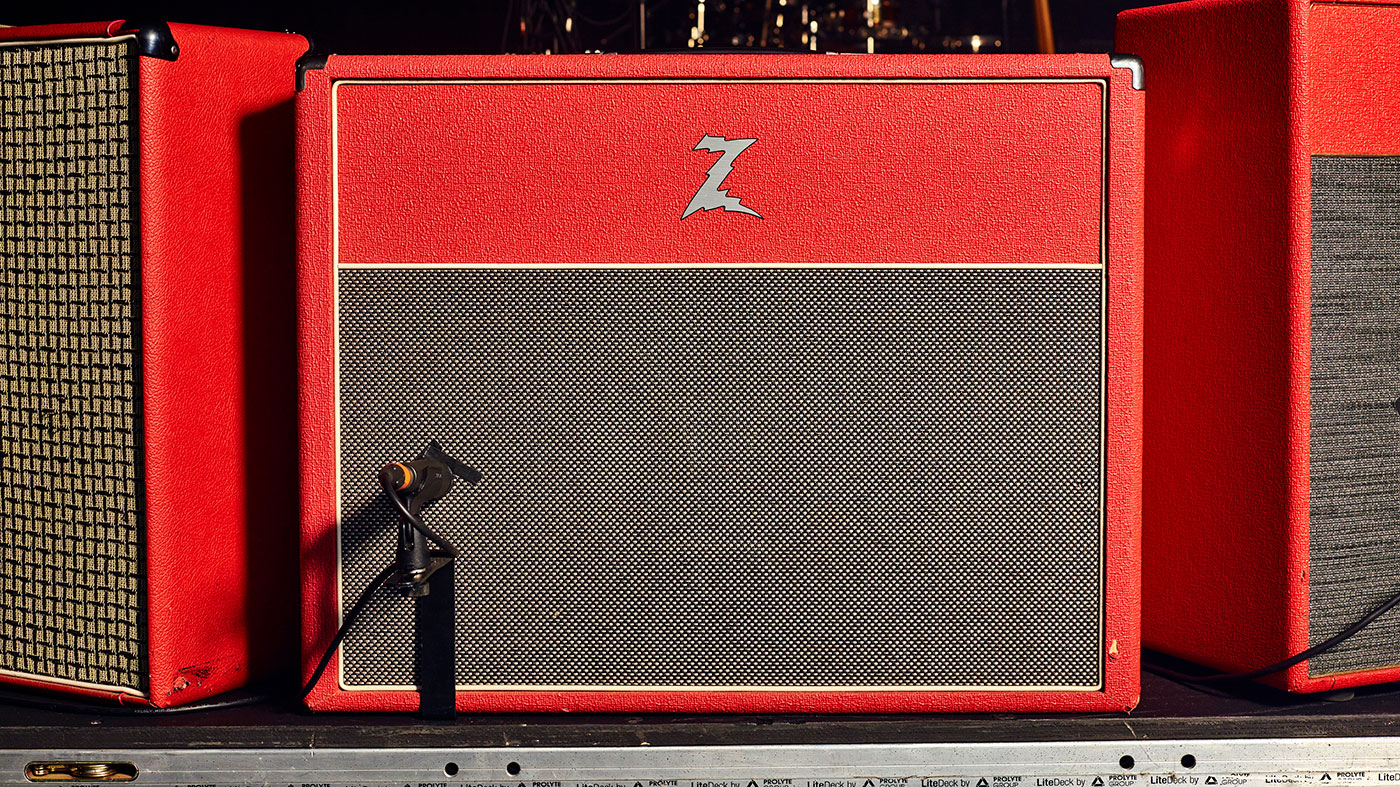
“The reason he has them angled away from him is that he wants to feel the air moving, but having them fire straight into the vocal mic has always been a conflict for the front of house guy, naturally! It makes all the difference in the world, because the vocal mic has great side rejection and these things are very directional.”

Brad's effects
Onto Brad’s effects rack, and from Shure wireless units, the pedals are then controlled via a combination of a Voodoo Labs Ground Control matrix and the RJM Effect Gizmo that also deals with amp switching and routing.
All effects go to all amps and Dave controls the vast majority of Brad’s pedal switching. And the pedals themselves…
Dumbloid: “It doesn’t sound anything like a Dumble,” says guitar tech Dave Rouze, “but it is a really great-sounding pedal, not super distorted, and he uses that for some lead sounds. He really likes it”
Wampler Plexi Drive: “This is a very specific sound that just gets used once”
Hermida Audio Zen Drive: “Basically a backup, we used to use it a lot but it’s basically been replaced by the Wampler Plexi Drive”
Wampler Paisley Drive: “This is Brad’s proto Paisley Drive and we use that quite a bit - maybe on a half-dozen songs. It’s one of his main overdrives, too”
CMAT Signa Comp: “This is used for certain clean sounds and never with drive”
Ibanez TS9 Tube Screamer: “He uses this all the time, it’s his go-to pedal. We use 808s and TS9s pretty much interchangeably, so I hope that ends some kind of fight out there on the internet! [laughs]”
Way Huge Green Rhino: “We use that specifically on the opening of Water. He does this Jaws lick. He used to do a Van Halen cover, Hot For Teacher, and he used it on that. We have this set really heavy and he only ever uses it dry”
Wampler Underdog: “Brian Wampler built it just for Brad and I believe there’s a version of it coming out with a combination of this and the Paisley Drive in one pedal”
Boss NS-2 Noise Suppressor: “This runs mostly on the wah-wah because it’s so noisy, but I don’t really gate anything else. The ’52 squeals a bit so it helps with that, too”
Boss DD-2: “These are becoming hard to find, and that’s Brad’s main sound as the slapback - on the 200ms setting, just a short slapback with two or three repeats. That’s what you hear on his clean sound pretty much all the time. That’s the secret to it!”
Way Huge Aqua Puss: “It’s a sound that Brad likes, really crunchy and analogue-y. For that specific sound, it’s the go-to”
Roland RE-20 Space Echo: “I use these for when we need to tap the delay in for the longer delay times”
Wampler Wheelhouse: “Brian built that for Brad - it’s got the tape warble on it but also tap-tempo, which is crucial,” says tech Dave Rouze
Line 6 M13: “This is for all the other stuff: a chorus in Riverbank; Old Alabama has a phaser and so on…”
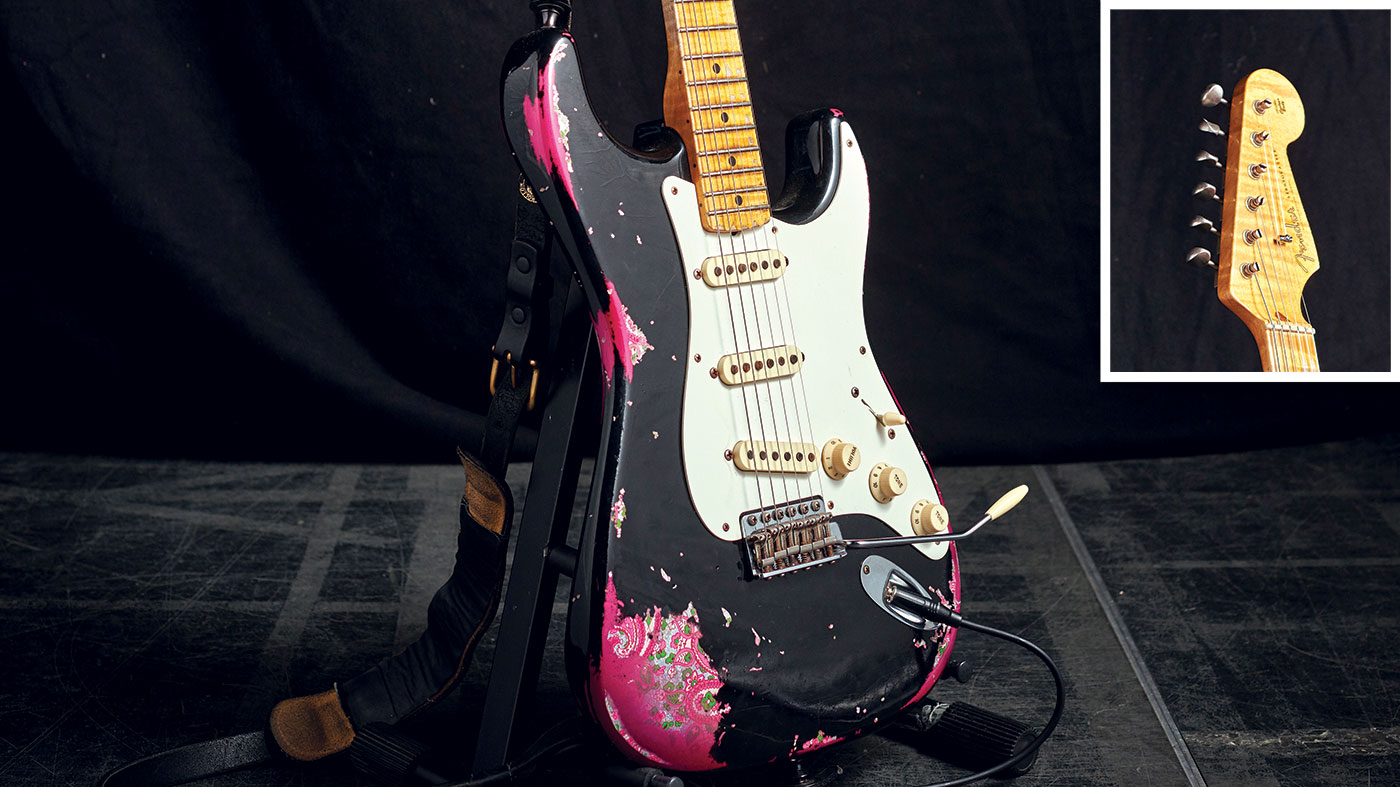
Fender Custom Shop Relic Stratocaster
“When I started working with him,” says guitar tech Dave Rouze, “he only used a Strat on She’s Everything and he had the bridge blocked off. I specialise in making these things work, so we set that trem up and got it working right.
“He started playing it and we were doing some shows with Lindsay Ell – she would come up and sing Whiskey Lullaby. He’d keep the Strat on for that song and just started doing these really cool bends with it. So it stayed!”


